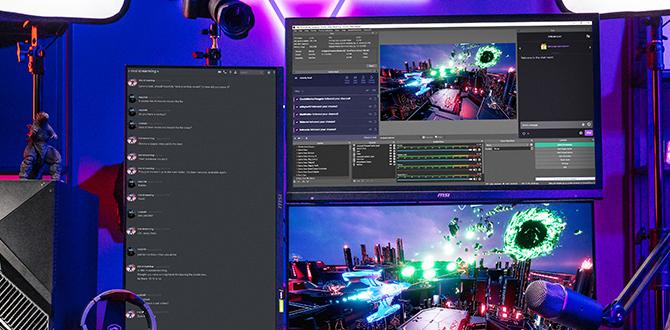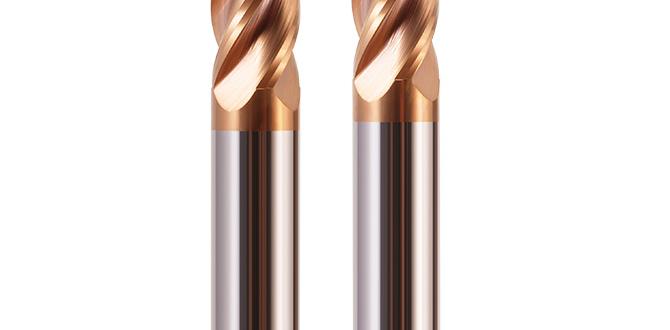Quick Summary: For machining Inconel 718, a TiAlN (Titanium Aluminum Nitride) coated ball nose end mill is essential. Its extreme hardness and heat resistance combat Inconel’s toughness, while the ball nose shape is perfect for complex contours and plunge milling, preventing tool breakage and ensuring smooth finishes.
Working with materials like Inconel 718 can feel like trying to carve granite with a butter knife. It’s tough, sticky, and loves to fight back against your cutting tools. Many machinists, especially those just starting out, run into frustrating issues like rapid tool wear, chipped cutters, and poor surface finishes when trying to machine this superalloy. It’s not you; it’s the material! But there’s a specific tool designed to tame Inconel: the TiAlN coated ball nose end mill. In this guide, we’ll break down exactly why this tool is your best friend for Inconel 718 and how to use it effectively.
Why is Inconel 718 So Tricky to Machine?
Before we dive into the solution, let’s understand the problem. Inconel 718 is an advanced nickel-chromium superalloy. It was developed for high-temperature applications, meaning it’s incredibly strong and resistant to heat, corrosion, and oxidation. These are fantastic properties for jet engines and other demanding environments, but they make it a nightmare for machining.
Here’s what makes Inconel 718 so challenging:
- High Hardness: Even at room temperature, Inconel 718 is significantly harder than materials like aluminum or mild steel.
- Work Hardening: As you cut into it, the material under the cutting edge gets even harder. This rapidly dulls conventional tools.
- Low Thermal Conductivity: Heat generated during cutting doesn’t dissipate well. It gets concentrated at the cutting edge, leading to tool failure.
- Gummy Texture: Inconel tends to “gum up” on the cutting tool, causing friction, increased cutting forces, and poor chip management.
- High Cutting Forces: All these factors combine to require much higher forces to make a cut.
Introducing the TiAlN Coated Ball Nose End Mill: Your Inconel Champion
When faced with a material as demanding as Inconel 718, you need tools specifically engineered to handle it. This is where the TiAlN coated ball nose end mill shines. Let’s break down its key features:
What is TiAlN Coating?
TiAlN stands for Titanium Aluminum Nitride. This is a premium PVD (Physical Vapor Deposition) coating applied to the surface of a cutting tool. Think of it as a super-hard, heat-resistant shield.
- Extreme Hardness: TiAlN coatings provide a significant increase in surface hardness, helping the tool resist abrasion and wear, especially against hard materials like Inconel.
- High-Temperature Resistance: This coating can withstand much higher cutting temperatures than uncoated tools or tools with more basic coatings like TiN (Titanium Nitride). This is crucial because Inconel cutting generates a lot of heat. The TiAlN coating forms a protective oxide layer at high temperatures, which further enhances its wear resistance.
- Reduced Friction: While its primary benefits are hardness and heat resistance, the smooth surface of the coating also helps reduce friction between the chip and the tool.
- Lubricity: The inherent properties of the nitride layer contribute to better chip flow and reduced built-up edge (BUE) when machining difficult materials.
For Inconel 718, TiAlN is often the preferred coating over simpler options because of its superior performance at high temperatures and extreme hardness. For a deeper dive into advanced coatings, the Sandvik Coromant site offers excellent insights into the world of cutting tool coatings.
What is a Ball Nose End Mill?
A ball nose end mill, also known as a “ball end mill,” has a tip that is perfectly hemispherical, forming a full radius. This shape is fundamentally different from flat-end or corner-radius mills.
- Full Radius Tip: The entire tip is a sphere, meaning it has no sharp corners.
- Versatile Cutting: It can cut on its periphery and is especially useful for generating complex 3D shapes and contours.
- Plunge Milling Capability: The rounded tip allows it to plunge directly into the material vertically, which is a key feature we’ll discuss later.
- Smooth Surface Finishes: In 3D contouring, the ball nose leaves a smooth, consistent surface finish, which is essential when precise surface quality is required.
Why Both TiAlN and Ball Nose are Essential for Inconel 718
Combining these features creates a tool that is purpose-built for tackling Inconel 718:
- Heat and Wear Resistance (TiAlN): Directly combats the high temperatures and abrasion caused by Inconel’s properties.
- Contouring and Complex Shapes: The ball nose is ideal for creating the intricate curves and surfaces often found in Inconel 718 parts (like turbine blades or aerospace components).
- Plunge Milling: This technique is crucial for efficient material removal in certain applications, and the ball nose is uniquely suited for it. The 55-degree angle spec you mentioned often refers to the helix angle leading to the tip, optimized for plunge milling.
- Reduced Tool Pressure: While still high, the combined properties help manage the cutting forces better than less specialized tools.
Key Considerations When Selecting Your TiAlN Ball Nose End Mill
Not all TiAlN ball nose end mills are created equal, especially when it comes to Inconel. Here are a few things to look for:
Material of the End Mill
For Inconel, the base material of the end mill itself needs to be robust. Look for:
- Solid Carbide: This is the standard for high-performance end mills. Carbide offers excellent hardness and rigidity.
- High Cobalt Content: Higher cobalt content in carbide tools (e.g., 10% or 12%) generally increases toughness and resistance to chipping, which is beneficial for hard materials.
- Advanced Grades: Some manufacturers offer specific carbide grades optimized for difficult-to-machine materials.
Coating (TiAlN) Specifics
While TiAlN is the go-to, some variations exist:
- Al Content: Higher aluminum content in the TiAlN coating (e.g., Ti3AlN or TiAlN with >50% Al) offers superior oxidation resistance at very high temperatures.
- Multi-layer Coatings: Advanced manufacturers might use multi-layer coatings that combine elements for even better performance.
Number of Flutes
The number of cutting edges (flutes) on an end mill affects chip clearance and rigidity.
- 2-Flute: Generally preferred for plunge milling and slotting because it provides better chip evacuation in confined spaces. This can be very useful when plunging into Inconel.
- 3-Flute: A good general-purpose option offering a balance of rigidity and chip clearance.
- 4-Flute: Offers more rigidity and better surface finish in general milling but can struggle with chip evacuation in deep slots or when plunging.
For plunge milling Inconel 718, a 2-flute TiAlN ball nose end mill with a 55-degree helix angle is often specified to manage the heat and chip load effectively during the plunge operation.
Helix Angle
The helix angle refers to the angle of the cutting flutes around the tool’s axis. A higher helix angle generally leads to a smoother cutting action and better chip evacuation but can also increase cutting forces and radial pressure.
- Lower Helix Angle (e.g., 30 degrees): More rigid cut, better for very hard materials where stability is paramount, but poorer chip evacuation.
- Higher Helix Angle (e.g., 45-60 degrees): Smoother cutting action, better chip evacuation, good for general milling and harder materials when appropriate. For plunge milling and aggressive work on Inconel, a specific design, sometimes marketed with a 55-degree lead to the tip, is optimized.
Diameter and Corner Radius
These are straightforward but critical:
- Diameter: Choose the diameter appropriate for your part features.
- Corner Radius: The ball nose means the corner radius is half the diameter. Ensure the radius is suitable for your intended profiling and finishing.
Machining Parameters: The Secret Sauce for Inconel 718
Even with the perfect tool, incorrect cutting speeds and feeds will lead to rapid tool failure when machining Inconel. This is where machinists often get into trouble. Inconel needs to be machined at relatively low speeds but with a good depth of cut and feed rate to keep the cutting edge engaged in fresh material and prevent overheating.
Here’s a general guide, but always consult the end mill manufacturer’s recommendations and your machine’s capabilities:
Cutting Speed (Surface Speed)
This is the speed at which the cutting edge moves across the material. For Inconel 718 with a TiAlN ball nose end mill, you’ll typically be in the lower to moderate range.
- General Range: 20-60 SFM (Surface Feet per Minute) or 6-18 m/min (meters per minute).
- What to aim for: A light, continuous chip that has a slight blue tint will indicate you’re in the right zone. Very light chips mean you’re too fast, and dull gray or burnt chips mean you’re too slow or have too much friction.
Example: For a 1/2 inch (12.7 mm) diameter end mill, if you set your spindle to 50 SFM, your RPM would be approximately 382 RPM (SFM 3.82 / Diameter in inches).
Feed Rate
This is how fast the tool advances into or through the material.
- Chip Load: This is the thickness of the chip being removed per tooth per revolution. For Inconel, a moderate chip load is crucial. Too small, and you risk rubbing and overheating; too large, and you risk tool breakage.
- General Chip Load: 0.001 – 0.004 inches per tooth (0.025 – 0.1 mm per tooth) for Inconel with smaller diameter tools. This will increase slightly for larger diameters.
- Feed Rate (IPM/mm/min): Feed Rate = Chip Load × Number of Flutes × Spindle Speed (RPM).
Example: Using the 1/2 inch end mill example above running at 382 RPM with a 0.002 inch chip load and 2 flutes: Feed Rate = 0.002 in/tooth × 2 flutes × 382 RPM = 1.53 IPM (approx 39 mm/min).
Depth of Cut (Axial and Radial)
This is how deep the tool cuts into the material.
- Axial Depth of Cut (AP): How deep the tool cuts along the Z-axis. For Inconel, you often need to use shallower depths of cut than you might with softer materials to manage forces. A good starting point might be 0.1x to 0.5x the tool diameter, depending on the operation (e.g., 0.1 x diameter for finishing, 0.5 x diameter for roughing if rigidity allows).
- Radial Depth of Cut (AE): How deep the tool cuts into the side (the width of the cut). For roughing, you might take a larger radial cut (e.g., 50% of the tool diameter). For finishing or slotting, you’ll take a much smaller radial cut, often a “stepover” of 10-40% of the diameter.
Coolant/Lubrication
This is non-negotiable for Inconel.
- Flood Coolant: Using a flood coolant system that floods the cutting zone is essential. It cools the tool and workpiece, flushes chips away, and lubricates the cut.
- High-Pressure Coolant: Many high-performance end mills have through-flute coolant holes. Using high-pressure coolant (e.g., 500-1000 PSI) delivered through these holes directly to the cutting edge dramatically improves chip evacuation and cooling.
- Cutting Fluids: Use a high-quality synthetic or semi-synthetic metalworking fluid designed for difficult-to-machine alloys. Sometimes, a specialized heavy-duty cutting paste or high-temperature lubricant can be beneficial during critical cuts.
Tool Holder and Machine Rigidity
These are often overlooked but critical for success:
- Rigid Tool Holding: Always use a high-quality tool holder, such as a hydraulic chuck or a shrink-fit holder, for maximum rigidity and runout control. Avoid collet chucks for Inconel if possible, as they offer less rigidity.
- Machine Rigidity: Your milling machine must be rigid enough to handle the cutting forces. A machine with significant backlash, worn ways, or a flexible spindle will struggle.
How to Plunge Mill with a Ball Nose End Mill in Inconel 718
Plunge milling is a technique where the end mill descends vertically into the material to create a pocket or slot. The ball nose end mill is particularly good for this because its rounded tip allows for a smooth entry and exit without the shock load on a flat-end mill.
Here’s a step-by-step approach:
- Set Up Your Tool:
- Securely install your TiAlN coated ball nose end mill (consider 2 flutes with a 55-degree helix for this task) into a rigid tool holder.
- Ensure the tool is correctly measured and loaded into the CNC or your manual milling machine’s spindle.
- Verify your coolant system is operational and set to appropriate pressure/flow.
- Establish Zero and Tool Path:
- Set your XY and Z zeros accurately on the workpiece.
- Program or establish your plunge depth. For Inconel, start conservatively.
- Define the XY path for the plunge. This could be a single point to plunge straight down, or a helical path down if your controller supports it and the tool’s design is suitable.
- Initiate the Plunge:
- Begin with a conservative cutting speed and feed rate as discussed above.
- Engage the coolant before* the tool touches the material.
- Start the spindle rotation.
- Descend the tool into the material at the programmed feed rate. The 55-degree helix angle of specialized plunge milling end mills helps guide the tool and manage chips during this phase.
- Chip Evacuation is Key:
- Monitor chip formation. The chips should be small and consistent.
- If you notice bird-nesting (long, stringy chips) or hear the tool rubbing, you may need to adjust feed rate, depth of cut, or coolant flow. Short dwell pauses at the bottom of the plunge can also help break chips in some cases.
- Withdraw the Tool:
- Once the programmed depth is reached, dwell for a moment if needed to ensure complete chip clearing.
- Retract the tool at the same feed rate or faster.
- Turn off the spindle and coolant only after the tool is clear of the workpiece.
- Inspect and Adjust:
- Carefully inspect the machined pocket for surface finish and dimensional accuracy.
- Check the tool for excessive wear or chipping.
- Based on the results, adjust your parameters (speed, feed, depth of cut) for the next operation or part. For Inconel 718, iterative adjustments are almost always necessary.
The use of specialized “plunge milling” end mills often involves a specific geometry, like the 55-degree helix, designed to create a shearing action at the bottom of the plunge that helps break chips effectively.
Alternatives and When to Use Them
While TiAlN ball nose end mills are excellent, other options exist for specific situations:
Uncoated Carbide Ball Nose End Mills
- Pros: Cheaper, can provide good results in less demanding Inconel machining or if your machine has




